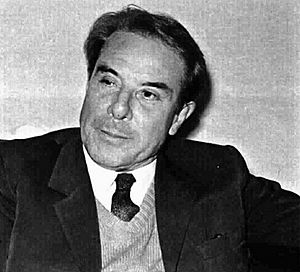Renato Castellani facts for kids
Renato Castellani (born September 4, 1913, died December 28, 1985) was a famous Italian film director and screenwriter. He was known for making movies and writing their scripts.
Contents
Early Life and Education
Renato Castellani was born in Varigotti, Italy, on September 4, 1913. His father worked for Kodak, a company known for cameras and film. Renato spent his early childhood in Argentina, in a city called Rosario.
When he was 12, he moved back to Liguria, Italy. He continued his studies in Genoa and later moved to Milan. In Milan, he studied architecture at the Polytechnic University. While there, he also explored radio work. He experimented with new ways to edit sound for radio shows.
Starting His Film Career
Castellani began working in movies in 1936. He first helped as a military expert for the film The Great Appeal. He also wrote about movies as a film critic.
He worked with many important Italian filmmakers. He wrote scripts and was an assistant director. Some famous directors he worked with include Augusto Genina, Mario Soldati, and Alessandro Blasetti. He helped write scripts for films like Castles in the Air (1939) and The Iron Crown (1941).
Directing His Own Films
Renato Castellani directed his first movie, A Pistol Shot, in 1942. This film was based on a story by Alexander Pushkin. His early films, including Zazà (1942), were part of a style called "caligraphism." This style focused on beautiful visuals and careful storytelling.
Castellani then created a new kind of film. He made movies like Under the Sun of Rome (1948) and It's Forever Springtime (1950). These films were often shot outdoors and sometimes used actors who were not professionals.
His film Two Cents Worth of Hope (1952) became very popular. These movies were called "pink neorealism." This style was a lighter, more hopeful version of neorealism, which showed real life after World War II.
Awards and Later Works
Renato Castellani won important awards for his films.
- In 1952, Two Cents Worth of Hope won the top prize, the Grand Prix, at the 1952 Cannes Film Festival.
- In 1954, his film Romeo and Juliet won the Golden Lion at the Venice Film Festival.
After these successes, Castellani made other notable films like Dreams in a Drawer (1957). He also started making popular TV shows. These shows were often "biopics," which are films or series about the lives of real people. Two of his well-known TV series were The Life of Leonardo da Vinci (1971) and The Life of Verdi (1982).
Filmography
Renato Castellani worked on many films as a director or writer.
Films He Directed
- A Pistol Shot (1942)
- Zazà (1942)
- The Woman of the Mountain (1943)
- Professor, My Son (1946)
- Under the Sun of Rome (1948)
- It's Forever Springtime (1950)
- Two Cents Worth of Hope (1952)
- Romeo and Juliet (1954)
- Dreams in a Drawer (1957)
- Nella città l'inferno (1959)
- The Brigand (1961)
- Mare matto (1963)
- Countersex (1964)
- Three Nights of Love (1964)
- Ghosts - Italian Style (1967)
- Brief Season (1969)
Television Series
- The Life of Leonardo da Vinci (Rai, 1971)
- Il furto della Gioconda (Rai, 1978)
- The Life of Verdi (Rai, 1982)
See also
 In Spanish: Renato Castellani para niños
In Spanish: Renato Castellani para niños
- Cinema of Italy
- Neorealism
- Caligraphism
External links




